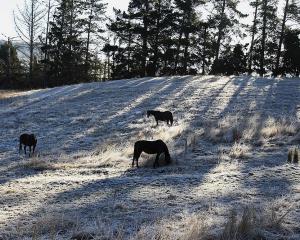Smatterings of rainfall throughout much of the country this week failed to bring drought relief to the most parched regions.
Eastern parts of Northland had up to 120mm of much-welcomed rain over the past two days, but the rest of the region received only light cover.
"Certainly on the eastern side it's made a huge relief. It was good rain over a long period of time as opposed to a lot of rain over a short period of time where you'd get more run-off, so this was really good, soaking rainfall," Northland Regional Council water resources/hydrology programme manager Dale Hansen said.
But many Northland farmers remained on tenterhooks as winter loomed, and they faced feed shortages.
The Northland drought was the worst the region had experienced since 1945-1946, and at this rate it would eclipse even that, Helen Moodie of Northland Rural Support Trust said.
A steady stream of farmers had approached the trust, which gives assistance to rural communities in times of hardship, but it could provide only advice about how to manage farms during drought, and minimal financial assistance.
"The only direct financial assistance is the equivalent of the unemployment benefit, it's to meet the family needs, and it's very hard to apply for," she said.
There was enough feed available for purchase on the commercial market, but many farmers were struggling to meet that cost, she said.
Neil Bateup of the Waikato/Hauraki/Coromandel Rural Relief Trust said the Eastern Waikato had about 40mm of rain overnight.
While things looked greener than they did yesterday, the drought was not over until there was adequate feed, and even then it may take years for farmers to recover from the financial burden it had placed on them, he said.
"There's certainly no feed there yet," he said.
Waikato Federated Farmers president Stewart Wadey said about seven percent of the region's farmers were struggling to find the money to buy feed, and had been in regular contact with banks for funds.
While a 40 cent increase in Fonterra's forecast milk payout had relieved much of the stress for some, the Waikato would need about 80mm of rain to replenish the soil's moisture, he said.
In Bay of Plenty, National Institute of Water and Atmospheric Research (Niwa) maps showed very dry soil over the region. Bay of Plenty Rural Support Trust chairman Derek Spratt said it would take about 100mm of rain over a week to substantially improve the situation, and there was no such a downpour expected in the next six weeks or so.
He urged farmers to get help if they needed it. It was not too late to act by culling cows, using feeding supplement, selling trading stock and securing a water supply.
Areas with limited water supply should be grazed first, he said.
In Otago it was a similar story. Irene Scurr of Otago Adverse Events Trust said there had been good rains in the Maniototo and coastal Otago areas, but Central Otago was still very dry.
Ministry of Agriculture and Forestry North Island regions manager Phil Journeaux said the forecast for most of the country was promising for the rest of the week.
"Assuming the North island got some rain in the next few days I'd be optimistic we'd get some pasture growth to go into winter. But it's starting to get cold in the South Island and we're starting to get a bit of frost so even if they do get rain they're not necessarily going to get a lot of pasture growth," he said.







